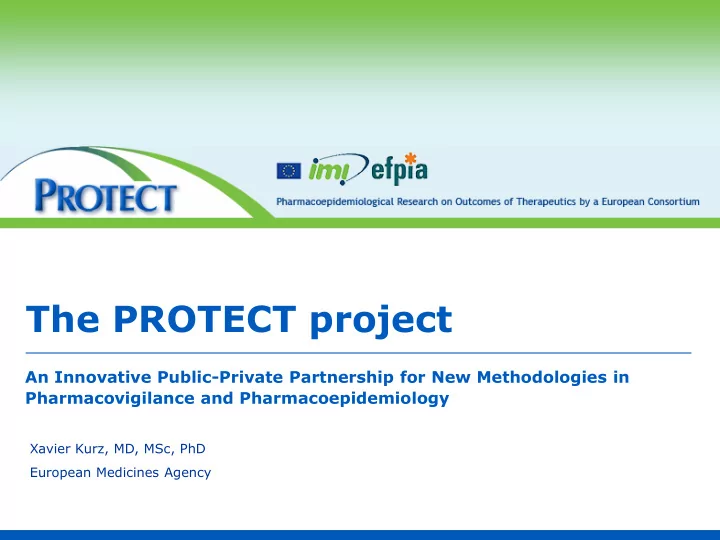

The PROTECT project An Innovative Public-Private Partnership for New Methodologies in Pharmacovigilance and Pharmacoepidemiology Xavier Kurz, MD, MSc, PhD European Medicines Agency
PROTECT Goal To strengthen the monitoring of benefit-risk of medicines in Europe by developing innovative methods to enhance early detection and assessment of adverse drug to enable the integration reactions from different data and presentation of data sources (clinical trials, on benefits and risks spontaneous reporting and observational studies) These methods will be tested in real-life situations. 2
WP 2: Framework for pharmacoepidemiological studies Objectives: To: • develop • test • disseminate methodological standards for the: • design • conduct • analysis of pharmacoepidemiological studies applicable to: • different safety issues • using different data sources 3
Work Package 2: Framework for pharmacoepidemiological studies Adverse event – drug pairs Antidepressants (incl. Benzodiazepines) - Hip Fracture Antibiotics - Acute liver injury Beta2 Agonists - Myocardial infarction Antiepileptics - Suicide Calcium Channel Blockers - Cancer Databases British THIN databases Danish national registries Spanish BIFAP project Dutch Mondiaan database German Bavarian claims database British GPRD database Protocols Cohort, nested case-control, population-based case-control, case- crossover, self-controlled case series Manuscript Bridging differences in findings from observational pharmaco- epidemiological studies: the PROTECT project 4
Work Package 2 – Confounding Drug utilisation Simulation studies and methods to quantify balance of confounder distributions with propensity score methods Manuscripts: - Measuring balance and model selection in propensity score methods - Selection of confounding variables should not be based on observed associations with exposure - Balance measures for propensity score methods: a clinical example on beta-agonist use and the risk of myocardial infarction Evaluation and dissemination of methodologies for drug utilisation studies in order to estimate public health impact of adverse drug reactions – Inventory of data sources on drug utilisation data for several European countries – Collaboration with EuroDURG 5
Work Package 3: Signal Detection Objective: To improve early and proactive signal detection from spontaneous reports, electronic health records, and clinical trials. 6
Work Package 3: Sub-projects 1. Merits of disproportionality analysis 2. Structured database of known ADRs 3. Concordance with risk estimates 4. Signal detection recommendations 5. Better use of existing ADR terminologies 6. Novel tools for grouping ADRs 7. Other information to enhance signal detection 8. Signal detection based on SUSARs 9. Subgroups and risk factors 10. Signal detection in Electronic Health Records 11. Drug-drug interaction detection 12. Duplicate detection 7
Structured database of product information on adverse drug reactions • Objective: Making available, in a structured format, already known ADRs • All 375 SPCs of CAPs (substances). Addition of non-CAPs under discussion. • Proof-of-concept analysis of free text extraction algorithm – Initial match rate increased from 72% to 98% 8
Work Package 4: Data collection from consumers Objectives: To assess the feasibility, efficiency and usefulness of modern methods of data collection including using web-based data collection and computerised, interactive voice responsive systems (IVRS) by telephone 9
Work Package 4 - Project Definition • Prospective, non interventional study which recruits pregnant women directly without intervention of health care professional • Collect data from them throughout pregnancy using either web based or interactive voice response systems (IVRS): – medication usage, lifestyle and risk factors for congenital malformation • Compare data with that from other sources and explore differences • Assess strengths and weaknesses of data collection and transferability to other populations 10
Work package 4 - Study population • 4 countries: Denmark United-Kingdom The Netherlands Poland • 1400 pregnant women per country – Self identified as pregnant – Volunteers may not be “typical” of pregnant population – can characterise 11
Work Package 4: Patient workflow overview Study subject picks up a leaflet in Study subject enrolls for a pharmacy or browses specific the web or phone (IVRS) web sites to find out about the method of data collection. study in one of 4 countries. IVRS Web n = 200 per country n = 1200 per country Study subject completes the surveys Study subject completes the via an outbound reminder or by surveys online. inbound call she initiates. Final outcome survey is completed at the end of pregnancy. 12
Work Package 5: Benefit-Risk Integration and Representation Objectives: • To assess and test methodologies for the benefit-risk assessment of medicines • To develop tools for the visualisation of benefits and risks of medicinal products Perspectives of patients, healthcare prescribers, regulatory agencies and drug manufacturers From pre-approval through lifecycle of products 13
Work Package 5: Overview • Wave 1: has 4 case studies: Raptiva, Tysabri, Ketek and Acomplia. • Drugs which have data readily available from • PrOACT-URL framework for EPARs. WS C performing benefit-risk analysis. • Not revisiting EMA decisions, but use to Case studies • Oversee working parties for demonstrate and test methodologies. extracting objective measures of magnitude / incidence of benefits • Review of existing methods not inventing new and risks. methods. • Emphasis on graphical representation. WS D • Methods estimating(1) magnitude / incidence of Framework / events and (2) value elicitation of benefits and risks, from a patient and regulator perspective Data and how combine them into a single measure. WS F Application WS B Methods • Apply the methodology to the case WS E • Not developing software, but explore studies using the data Software / • May also elicit the subjective value suitable existing software (possibly with adaptation). data for the benefits and risks. graphics 14 14 14
Work Package 6: Validation Objectives: • To validate and test the transferability and feasibility of methods developed in PROTECT to other data sources and population groups • To determine the added value of using other data sources as a supplement or alternative to those generally used for drug safety studies, in order to investigate specific aspects or issues. 15
Work Package 7: Training Platform https://w3.icf.uab.es/trainingopp 16
More information? Website: www.imi-protect.eu Email: Protect_Support@ema.europa.eu 17
Recommend
More recommend